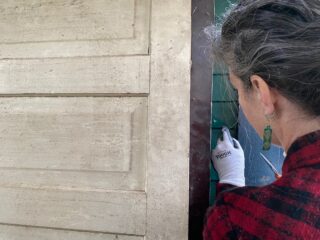Before beginning renovations in an older home, it is important to have a plan and keep safety at the forefront. Older homes and buildings can contain hazardous building materials that pose health risks when disturbed. Although you should always be working with a qualified professional, as an owner or steward of an older home or building it is also important that you be informed, know your risks around hazardous materials and make sure that the work done on your home implements safe practices for handling and disposing of potentially hazardous building fabric.
Additional Hazards
Visit for information about other potential hazards in construction and renovation:
Work Safe BC – Hazards & Exposures
Government of Canada – PCBs
Asbestos
Many older building materials may contain asbestos, which is important to address before any work begins. Asbestos fibers can stay in the air for hours and once inhaled, the body cannot break the material down, which can lead to long-term health issues.
Typical places where asbestos can be found in older homes include;
- Roofing shingles
- Siding
- Stucco
- Flooring
- Pipe wrapping
Asbestos is most dangerous when materials deteriorate or are disturbed such as during a renovation.
If you are planning a renovation and suspect that there could be asbestos-containing materials in your home, hire a qualified testing company. If they identify asbestos in your home, you can then work with a qualified asbestos abatement contractor to remove the material prior to beginning renovations. As a condition for the issuance of a building permit, a hazardous material assessment may be required. In no case should you disturb possible asbestos containing materials or attempt to remove them yourself.

Resources
City of Vancouver – Asbestos Disposal Policy
Work Safe BC – Asbestos Awareness for Homeowners
Work Safe BC – Asbestos Hazards When Renovating Older Homes
Health Link BC – Asbestos: When Should I Worry?
Government of Canada – Asbestos
Canadian Centre for Occupational Health and Safety – Asbestos – In the Home
Lead
Due to different waves of legislation it is theoretically possible to find lead-based paints in residential buildings constructed throughout the 20th century in Canada, particularly on exterior surfaces. For this reason, if you are planning interventions that are likely to disturb older paint it is important to always take safety precautions. If you want to be certain whether there is lead paint on surfaces in your home, you can send paint chip samples to a lab for analysis.
Lead-based paint is most dangerous if ingested or inhaled and presents the highest level of risk for growing children. It is most hazardous when disturbed, for instance when old paint needs to be prepared before applying a fresh coat of paint, which can include at least partial removal. Improper paint removal can expose people to lead-containing dust, so it is crucial to follow all established safety guidelines and to work with a qualified professional who is prepared to discuss your safety concerns.
One other possible source of lead contamination in the home is in old service lines and plumbing fixtures. Metro Vancouver is responsible for testing of the general water supply, but if lead is present in a building’s plumbing then water must be tested at the tap for accurate results. Consult a professional if you are concerned about older plumbing or elevated lead levels in your home.
